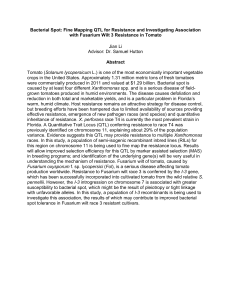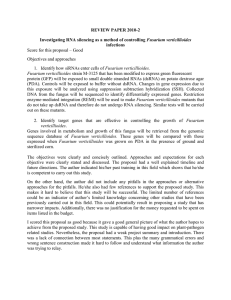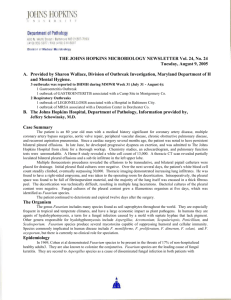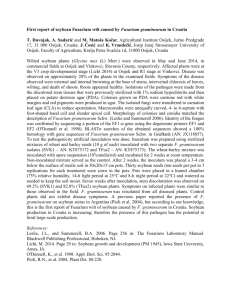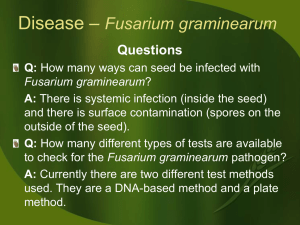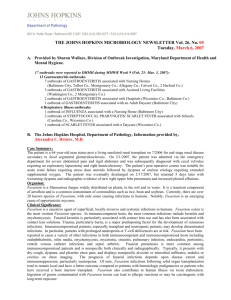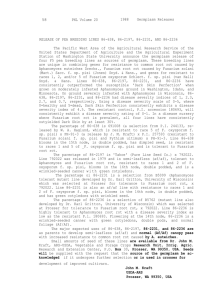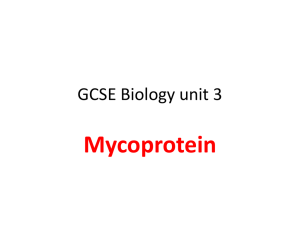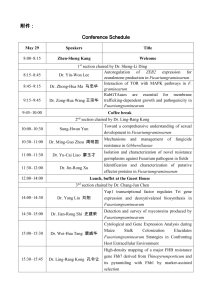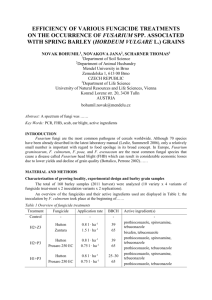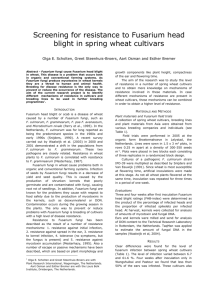Microsoft Word
advertisement
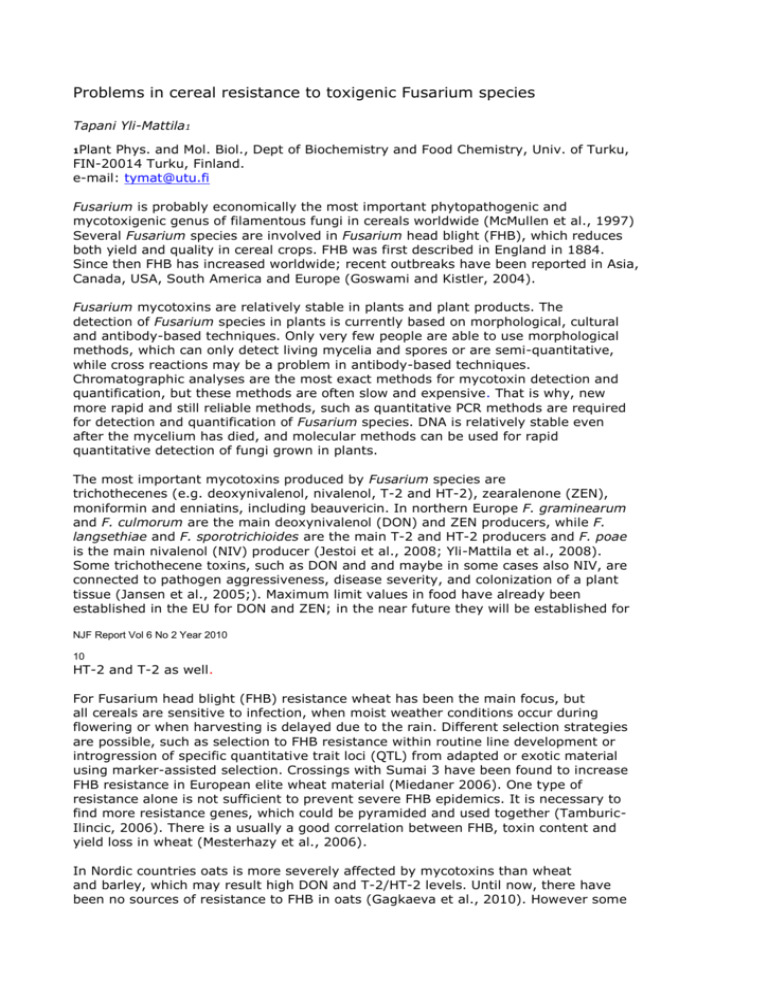
Problems in cereal resistance to toxigenic Fusarium species Tapani Yli-Mattila1 1Plant Phys. and Mol. Biol., Dept of Biochemistry and Food Chemistry, Univ. of Turku, FIN-20014 Turku, Finland. e-mail: tymat@utu.fi Fusarium is probably economically the most important phytopathogenic and mycotoxigenic genus of filamentous fungi in cereals worldwide (McMullen et al., 1997) Several Fusarium species are involved in Fusarium head blight (FHB), which reduces both yield and quality in cereal crops. FHB was first described in England in 1884. Since then FHB has increased worldwide; recent outbreaks have been reported in Asia, Canada, USA, South America and Europe (Goswami and Kistler, 2004). Fusarium mycotoxins are relatively stable in plants and plant products. The detection of Fusarium species in plants is currently based on morphological, cultural and antibody-based techniques. Only very few people are able to use morphological methods, which can only detect living mycelia and spores or are semi-quantitative, while cross reactions may be a problem in antibody-based techniques. Chromatographic analyses are the most exact methods for mycotoxin detection and quantification, but these methods are often slow and expensive. That is why, new more rapid and still reliable methods, such as quantitative PCR methods are required for detection and quantification of Fusarium species. DNA is relatively stable even after the mycelium has died, and molecular methods can be used for rapid quantitative detection of fungi grown in plants. The most important mycotoxins produced by Fusarium species are trichothecenes (e.g. deoxynivalenol, nivalenol, T-2 and HT-2), zearalenone (ZEN), moniformin and enniatins, including beauvericin. In northern Europe F. graminearum and F. culmorum are the main deoxynivalenol (DON) and ZEN producers, while F. langsethiae and F. sporotrichioides are the main T-2 and HT-2 producers and F. poae is the main nivalenol (NIV) producer (Jestoi et al., 2008; Yli-Mattila et al., 2008). Some trichothecene toxins, such as DON and and maybe in some cases also NIV, are connected to pathogen aggressiveness, disease severity, and colonization of a plant tissue (Jansen et al., 2005;). Maximum limit values in food have already been established in the EU for DON and ZEN; in the near future they will be established for NJF Report Vol 6 No 2 Year 2010 10 HT-2 and T-2 as well. For Fusarium head blight (FHB) resistance wheat has been the main focus, but all cereals are sensitive to infection, when moist weather conditions occur during flowering or when harvesting is delayed due to the rain. Different selection strategies are possible, such as selection to FHB resistance within routine line development or introgression of specific quantitative trait loci (QTL) from adapted or exotic material using marker-assisted selection. Crossings with Sumai 3 have been found to increase FHB resistance in European elite wheat material (Miedaner 2006). One type of resistance alone is not sufficient to prevent severe FHB epidemics. It is necessary to find more resistance genes, which could be pyramided and used together (TamburicIlincic, 2006). There is a usually a good correlation between FHB, toxin content and yield loss in wheat (Mesterhazy et al., 2006). In Nordic countries oats is more severely affected by mycotoxins than wheat and barley, which may result high DON and T-2/HT-2 levels. Until now, there have been no sources of resistance to FHB in oats (Gagkaeva et al., 2010). However some resistant lines have been formed (Bjornstad et al., 2006). One of the problems in breeding resistant cultivars in oats and barley is the lack of clear visual symptoms, which could be scored to assess the level of FHB. That is why other parameters connected to mycotoxins, such as Fusarium DNA, should be evaluated. Different commercial kits are available for DNA extraction and should be optimised for the fungal DNA from plant material. The quality and quantity of DNA can be estimated by gel electrophoresis and spectrophotometer or by different fluorescence methods. Fluorescence and gel electrophoresis are more specific than spectrophotometric analyses for quantification of DNA from grains. The amount of fungal DNA should be compared to the amount of total DNA obtained from plants. TaqMan real-time PCR can be used for quantifying DNA of Fusarium species in plants and the correlation between Fusarium graminearum DNA and DON levels have been good (e.g.. Waalwijk et al., 2004; Yli-Mattila et al., 2008). The advantage of TaqMan primers based on ribosomal DNA is that there are numerous ribosomal DNA copies in the genome, making the reaction more sensitive. Each Fusarium species has a species-specific mycotoxin profile, which means that in several cases there is a good correlation between Fusarium DNA and mycotoxins produced by them (Yli-Mattila et al., 2008). NJF Report Vol 6 No 2 Year 2010 11 Information regarding the effects of T-2 mycotoxin on humans has been collected from many incidents caused by moldy wheat or corn. One such incident with a mortality rate of 10-60 % took place in the Ural region in the former Soviet Union during World War II, when cereals could not be harvested before the winter. In North America dramatic changes have been found in the toxin chemotypes of F. graminearum. The 3ADON chemotype has been found to grow more quickly and to produce more trichothecenes and conidia than the 15ADON chemotype, which explains, why the 3ADON chemotype is spreading in North America and why a major shift from 15ADON to the more competitive 3ADON-producing strains has taken place. In the Russian Far East the 3ADON chemotype frequency increased between the years 1998-2006, and could reflect a shift in trichothecene chemotype composition similar to that observed within North America (Yli-Mattila, 2010). F. poae and F. langsethiae are usually the first Fusarium species in cereal heads. They may be competitors in cereal grains, because it has been found that tillage with ploughing increases the amount of F. poae, while the amount of F. langsethiae decreases as compared to direct drilling (Yli-Mattila, 2010). In future the current molecular methods will be improved, validated and automated, making it possible to use them in the routine identification, detection and quantification of Fusarium species for e.g. resistance studies. Molecular analyses require expensive equipment, but they allow quicker and more reliable identification with fewer people than traditional morphological identification. Internal standards should also be used in future to discriminate between uninfected samples and possible PCR inhibition (Waalwijk et al., 2004). The computer analysis of molecular data is also expected to improve and the total amount of sequence data in the databases will increase. The whole genome of F. graminearum, for instance, has already been sequenced (Guldener et al. 2006; Cuomo et al., 2007). The sequenced genome of Brachypodium The International Brachypodium Intitiative, 2010) will also help researchers in investigating the resistance in the subfamily Pooidae, including wheat, barley, rye and oat. Acknowledgements I am grateful for Dr. T. Gagkaeva (VIZR) for her comments on the manuscript. References Bjornstad, Å., Tarkegne Y., Sinnes H. 2006. 9th European Fusarium seminar: 87. NJF Report Vol 6 No 2 Year 2010 12 Edwards, S.G., Pirgozliev, S.R., Hare, M.C., Jenkinson, P. (2001) Applied and Environmental Microbiology 67: 1575-1580 Gagkaeva, T., Gavrilova, O, Yli-Mattila, T. Loskutov I. 2010. 11th European Fusarium seminar (in press). Goswami, R.S. and Kistler, C., (2004). Molecular Plant Pathology 5: 515-525. Guldener, U., Mannhaupt, G., Munsterkotter, M., Haase, D., Oesterheld, M. Stumpflen, V., Mewes, H.W. and Adam, G. (2006 Nucleic Acids Research 34: 456-458. The International Brachypodium Initiative 2010: Genome sequencing and analysis of the model grass Brachypodium distachyon Nature 463, 763-768 Jansen, C., von Wittstein, D., Schäfer, W., Kogel, K-H., Felk, A. and Maier F.J. (2005) Proceedings of the National Academy of Science 102: 16892-16897. Jestoi M., Paavanen-Huhtala S., Parikka S. and Yli-Mattila T. 2008. Archives of Phytopathology and Plant Protection 41: 545-558. Levitin M., 2004. In: Logrieco A., Visconti A. (eds.) An overview on toxigenic fungi and mycotoxins in Europe, pp. 195-199. Kluwer Academic Publishers, The Netherlands. McMullen M., Jones, R. and Gallenberg, D. 1997. Plant Disease 81: 1340-1346. Mesterhazy, A., Toth, B., Kaszonyi, G. Szabo-Hever, A., Bartok, T., Szekeres A. 2006. 9th European Fusarium seminar: 86. Miedaner T., 2006. 9th European Fusarium seminar: 82 Tamburic-Ilincic, L., Schaafsma, A., Falk, D., Eudes, F. 2006. 9th European Fusarium seminar: 84. Waalwijk, C., van der Heide, R., de Vries, I., van der Lee, T., Schoen, C., Costrel-de Corainville, G., Häuser-Hahn, I., Kastelein, P., Köhl, J, Lonnet, P., Demarquet, T. and Kema, G.H.J. 2004. European Journal of Plant Pathology 110: 481-494. Ward T.J., Clear R., Rooney A., O’Donnell K., Gaba D., Patrick S., Starkey D., Gilbert J., Geiser D., Nowicki T., 2008. Fungal Genetics and Biology 45: 473-484. Yli-Mattila, T. 2010. Ecology and evolution of toxigenic Fusarium species in cereals in northern Europe and Asia. - Journal of Plant Pathology 92:7-18. Yli-Mattila T., Gagkaeva T., Ward T.J., Aoki T., Kistler H.C., O’Donnell, K. 2009. Mycologia 101:841-852 . Yli-Mattila T., Paavanen-Huhtala S., Parikka P., Hietaniemi V., Jestoi M., Gagkaeva T., Sarlin T., Haikara A., Laaksonen S., Rizzo A., 2008. Archives of Phytopathology and Plant Protection 41: 243-260. NJF Report Vol 6 No 2 Year 2010 13
